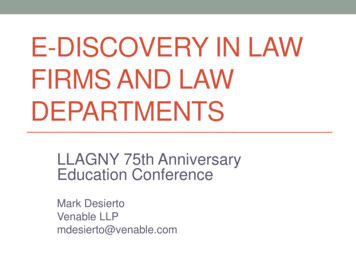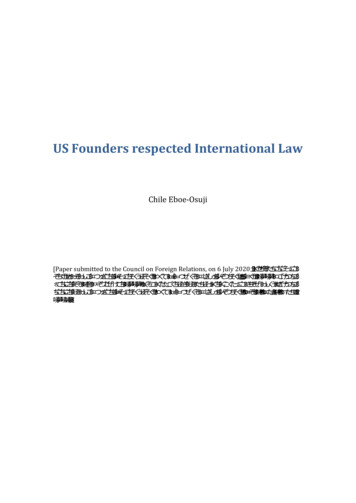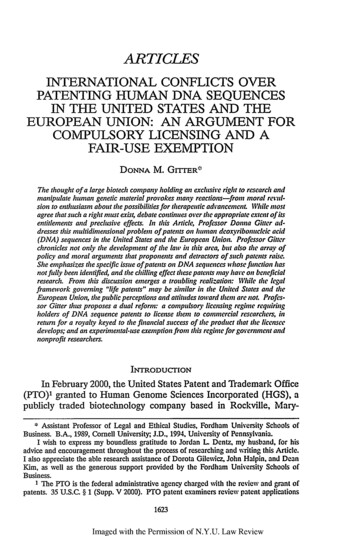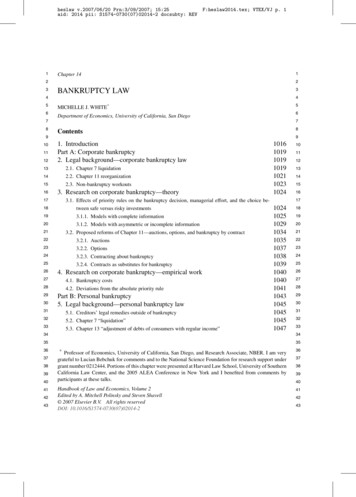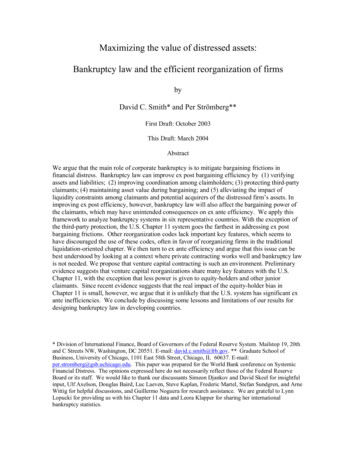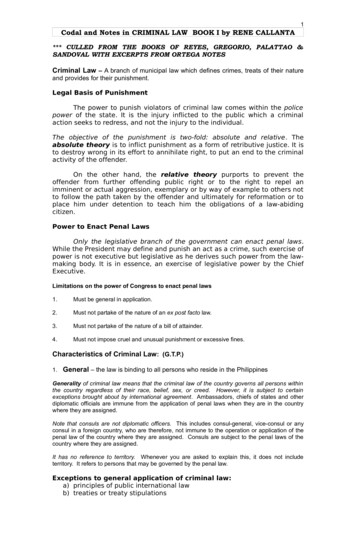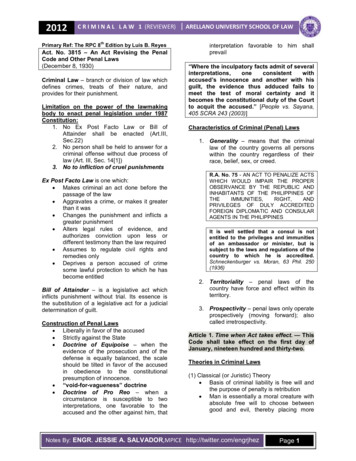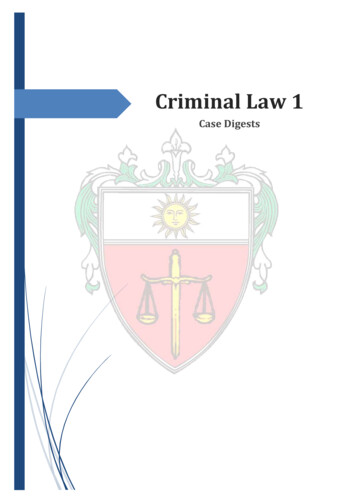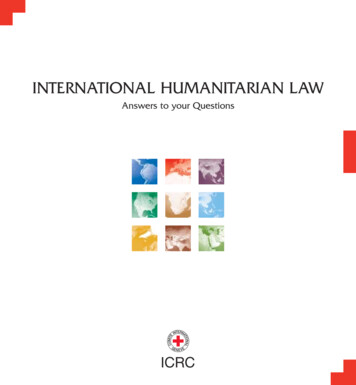
Transcription
INTERNATIONAL HUMANITARIAN LAWAnswers to your Questions
2THE INTERNATIONAL COMMITTEE OF THE RED CROSS (ICRC)Founded by five Swiss citizens in 1863 (Henry Dunant,Guillaume-Henri Dufour, Gustave Moynier, Louis Appia andThéodore Maunoir), the ICRC is the founding member of theInternational Red Cross and Red Crescent Movement. It is an impartial, neutral and independent humanitarian institution. It was born of war over 130 years ago. It is an organization like no other. Its mandate was handed down by the international community. It acts as a neutral intermediary between belligerents. As the promoter and guardian of international humanitarian law,it strives to protect and assist the victims of armed conflicts,internal disturbances and other situations of internal violence.The ICRC is active in about 80 countries and has some 11,000staff members (2003).The ICRC and the MovementThe International Committee of the Red Cross (ICRC) and theNational Red Cross and Red Crescent Societies, together with theInternational Federation of Red Cross and Red Crescent Societies(the Federation), combine to form the International Red Crossand Red Crescent Movement (the Movement). As a rule,representatives of those organizations meet every four years withrepresentatives of the States party to the Geneva Conventions atan International Conference of the Red Cross and Red Crescent.International Committee of the Red Cross19 Avenue de la Paix1202 Geneva, SwitzerlandT 41 22 734 6001 F 41 22 733 2057E-mail: icrc.gva@icrc.orgwww.icrc.orgOriginal: EnglishOctober 2002Basis for ICRC actionDuring international armed conflicts, the ICRC bases its work onthe four Geneva Conventions of 1949 and Additional Protocol Iof 1977 (see Q4). Those treaties lay down the ICRC’s right tocarry out certain activities such as bringing relief to wounded,sick or shipwrecked military personnel, visiting prisoners of war,aiding civilians and, in general terms, ensuring that thoseprotected by humanitarian law are treated accordingly.During non-international armed conflicts, the ICRC bases its workon Article 3 common to the four Geneva Conventions andAdditional Protocol II (see Index). Article 3 also recognizes theICRC’s right to offer its services to the warring parties with a viewto engaging in relief action and visiting people detained inconnection with the conflict.In violent situations not amounting to an armed conflict (internaldisturbances and other situations of internal violence), the ICRCbases its work on Article 5 of the Movement’s Statutes, whichsets out among other things the ICRC’s right of humanitarianinitiative. That right may also be invoked in international andnon-international armed conflicts.All these articles and laws together form the mandate given to theICRC by the international community, i.e. by the States.
SUMMARY OF QUESTIONS1. What is international humanitarian law?2. What are the essential rules of international humanitarian law?3. What are the origins of international humanitarian law?4. What treaties make up international humanitarian law?5. Who is bound by the Geneva Conventions?6. What are jus ad bellum and jus in bello?7. In what situations does humanitarian law apply? For whom is it intended and who does it protect?8. Does humanitarian law apply to the “new” conflicts?9. How does humanitarian law adapt to new developments and what is the ICRC’s role in the process?10. What does humanitarian law provide for in terms of material assistance to the victims of armed conflict?11. What does humanitarian law say with regard to the restoration of family links?12. What are the provisions of humanitarian law governing use of the emblem?13. How does humanitarian law protect refugees and internally displaced persons?14. What measures are available for implementing humanitarian law?15. What is the ICRC’s role in ensuring respect for humanitarian law?16. How are war criminals prosecuted under humanitarian law?17. What is the difference between humanitarian law and human rights law?468101214161820222426283032343618. Does humanitarian law apply to peace-keeping and peace-enforcement operations carried out byor under the auspices of the United Nations?3819. What does humanitarian law say about terrorism?39Index40Bibliography413
ICRC4Care for all wounded on the battlefield.1WHAT IS INTERNATIONAL HUMANITARIAN LAW?International humanitarian law forms amajor part of public international law (seeopposite) and comprises the rules which,in times of armed conflict, seek to protectpeople who are not or are no longer takingpart in the hostilities, and to restrict themethods and means of warfare employed.More precisely, what the ICRC means byinternational humanitarian law applicable inarmed conflicts is international treaty orcustomary rules which are specially intendedto resolve matters of humanitarian concernarising directly from armed conflicts, whetherof an international or non-internationalnature; for humanitarian reasons those rulesrestrict the right of the parties to a conflict touse the methods and means of warfare oftheir choice, and protect people and propertyaffected or liable to be affected by the conflict(see Q3, Q6 and Q17, which provide usefuladditional information).Geneva and The HagueWho fights whom?International humanitarian law (IHL) – also known as the lawof armed conflicts or law of war – (see Terminology opposite),has two branches: the “law of Geneva”, which is designed to safeguard militarypersonnel who are no longer taking part in the fighting andpeople not actively involved in hostilities, i.e. civilians; the “law of The Hague”, which establishes the rights andobligations of belligerents in the conduct of militaryoperations, and limits the means of harming the enemy.An international armed conflict means fighting between the armedforces of at least two States (it should be noted that wars of nationalliberation have been classified as international armed conflicts).The two branches of IHL draw their names from the citieswhere each was initially codified. With the adoption of theAdditional Protocols of 1977, which combine both branches,that distinction is now of merely historical and didactic value.I N T E R N AT I O N A L H U M A N I TA R I A N L AWA non-international armed conflict means fighting on theterritory of a State between the regular armed forces andidentifiable armed groups, or between armed groups fightingone another. To be considered a non-international armedconflict, fighting must reach a certain level of intensity andextend over a certain period of time.Internal disturbances are characterized by a serious disruption ofinternal order resulting from acts of violence which neverthelessare not representative of an armed conflict (riots, strugglesbetween factions or against the authorities, for example).
Grotius and the law of nationsIn current parlance, the law of nations is synonymous with theterm “public international law” or “international law”, which is thebody of rules governing relations between States and betweenthem and other members of the international community.relations. The law of nations was to provide that principle. Inhis book De jure belli ac pacis, Grotius listed rules which areamong the firmest foundations of the law of war.TerminologyGrotius (see Index), a jurist and diplomat, was the father of thelaw of nations. Following the Reformation, which divided theChristian church in Europe, he took the view that the law wasno longer an expression of divine justice but the fruit of humanreason and that it no longer preceded action but arose from it.Hence the need to find another uniting principle for internationalRefugeelawLaws governingthe peacefulsettlement erningStateresponsibilityThe expressions international humanitarian law, law of armedconflicts and law of war may be regarded as equivalents.International organizations, universities and even States willtend to favor international humanitarian law (or humanitarianlaw), whereas the other two expressions are more commonlyused by the armed ionsMaritimelawLawsgoverningair spaceLawsgoverningeconomicrelationsN.B. This figure is not to be interpreted as an attempt to classify or rank the various branches of public international law; it merelymentions some of the more well-known ones.5
Thomas Pizer/ICRC6“.as soon as they lay down [their arms] and surrender, they cease to be enemies or agentsof the enemy, and again become mere men, and it is no longer legitimate to take their lives.”2WHAT ARE THE ESSENTIAL RULESOF INTERNATIONAL HUMANITARIAN LAW?The parties to a conflict must at all timesdistinguish between the civilian populationand combatants in order to spare thecivilian population and civilian property.Neither the civilian population as a wholenor individual civilians may be attacked.Attacks may be made solely againstmilitary objectives. People who do not orcan no longer take part in the hostilities areentitled to respect for their lives and for theirphysical and mental integrity. Such peoplemust in all circumstances be protected andtreated with humanity, without anyunfavorable distinction whatever. It isforbidden to kill or wound an adversarywho surrenders or who can no longer takepart in the fighting.Neither the parties to the conflict normembers of their armed forces have anunlimited right to choose methods andmeans of warfare. It is forbidden to useweapons or methods of warfare that arelikely to cause unnecessary losses orexcessive suffering.The wounded and sick must be collectedand cared for by the party to the conflictwhich has them in its power. Medicalpersonnel and medical establishments,transports and equipment must be spared.The red cross or red crescent on a whitebackground is the distinctive signindicating that such persons and objectsmust be respected.These rules, drawn up by the ICRC, summarize the essence ofinternational humanitarian law. They do not have the authorityof a legal instrument and in no way seek to replace the treatiesI N T E R N AT I O N A L H U M A N I TA R I A N L AWCaptured combatants and civilians whofind themselves under the authority of theadverse party are entitled to respect for theirlives, their dignity, their personal rights andtheir political, religious and otherconvictions. They must be protectedagainst all acts of violence or reprisal. Theyare entitled to exchange news with theirfamilies and receive aid. They must enjoybasic judicial guarantees.in force. They were drafted with a view to facilitating thepromotion of IHL (see Index).
Fundamental principles of humanitarian lawLike Grotius (see p. 5 and Index), jurists and philosopherstook an interest in the regulation of conflicts well before the firstGeneva Convention of 1864 was adopted and developed.In the 18th century, Jean-Jacques Rousseau made a majorcontribution by formulating the following principle about thedevelopment of war between States:“War is in no way a relationship of man with man but arelationship between States, in which individuals are enemiesonly by accident; not as men, nor even as citizens, but assoldiers (.). Since the object of war is to destroy the enemyState, it is legitimate to kill the latter’s defenders as long as theyare carrying arms; but as soon as they lay them down andsurrender, they cease to be enemies or agents of the enemy,and again become mere men, and it is no longer legitimate totake their lives.”In 1899, Fyodor Martens laid down the following principle forcases not covered by humanitarian law: “(.) civilians andcombatants remain under the protection and authority of theprinciples of international law derived from establishedcustom, from the principles of humanity and from the dictatesof public conscience.”The above, known as the Martens clause, was alreadyconsidered a standard part of customary law when it wasincorporated in Article 1, paragraph 2, of Additional Protocol Iof 1977 (see Index).While Rousseau and Martens established principles ofhumanity, the authors of the St. Petersburg Declaration (seeQ4) formulated, both explicitly and implicitly, the principles ofdistinction, military necessity and prevention of unnecessarysuffering, as follows:“Considering: (.) That the only legitimate object which Statesshould endeavour to accomplish during war is to weaken themilitary forces of the enemy;That for this purpose it is sufficient to disable the greatestpossible number of men;That this object would be exceeded by the employment of armswhich uselessly aggravate the sufferings of disabled men, orrender their death inevitable.”The Additional Protocols of 1977 reaffirmed and elaborated onthese principles, in particular that of distinction: “(.) theParties to the conflict shall at all times distinguish between thecivilian population and combatants and between civilianobjects and military objectives and accordingly shall direct theiroperations only against military objectives.” (Art. 48, Protocol I;see also Art. 13, Protocol II).Finally, the underlying principle of proportionality seeks to strikea balance between two diverging interests, one dictated byconsiderations of military need and the other by requirementsof humanity when the rights or prohibitions are not absolute(see also p. 9).7
Elchin Mamedov/ICRC8“.to prevent the strong from oppressing the weak”3WHAT ARE THE ORIGINS OF INTERNATIONAL HUMANITARIAN LAW?To answer this question we have to askother questions.What law governed armed conflictsprior to the advent of contemporaryhumanitarian law?First there were unwritten rules based oncustoms that regulated armed conflicts.Then bilateral treaties (cartels) drafted invarying degrees of detail gradually cameinto force. The belligerents sometimesratified them after the fighting was over.There were also regulations which Statesissued to their troops (see The Lieber Codeopposite). The law then applicable inarmed conflicts was thus limited in bothtime and space in that it was valid for onlyone battle or specific conflict. The rules alsovaried depending on the period, place,morals and civilization.Who were the precursors ofcontemporary humanitarian law?Two men played an essential role inits creation: Henry Dunant and Guillaume-Henri Dufour (see p. 2). Dunant formulatedthe idea in A Memory of Solferino,published in 1862. On the strength of hisown experience of war, General Dufour lostno time in lending his active moral support,notably by chairing the 1864 DiplomaticConference.Dunant:“On certain special occasions, as, forexample, when princes of the military artbelonging to different nationalities meet (.)would it not be desirable that they shouldtake advantage of this sort of congress toformulate some international principle,sanctioned by a Convention and inviolate incharacter, which, once agreed upon andratified, might constitute the basis forsocieties for the relief of the wounded in thedifferent European countries?”Dufour (to Dunant):“We need to see, through examples asvivid as those you have reported, what theglory of the battlefield produces in terms oftorture and tears.”I N T E R N AT I O N A L H U M A N I TA R I A N L AWHow did the idea become a reality?The Swiss government, at the prompting ofthe five founding members of the ICRC (seep. 2), convened the 1864 DiplomaticConference, which was attended by 16States who adopted the Geneva Conventionfor the amelioration of the condition of thewounded in armies in the field.What innovations did thatConvention bring about?The 1864 Geneva Convention laid thefoundations for contemporary humanitarianlaw. It was chiefly characterized by: standing written rules of universal scopeto protect the victims of conflicts; its multilateral nature, open to all States; the obligation to extend care withoutdiscrimination to wounded and sickmilitary personnel; respect for and marking of medicalpersonnel, transports and equipmentusing an emblem (red cross on awhite background).
Humanitarian law prior to its codificationIt would be a mistake to claim that the founding of the RedCross in 1863, or the adoption of the first Geneva Conventionin 1864, marked the starting point of internationalhumanitarian law as we know it today. Just as there is nosociety of any sort that does not have its own set of rules, sothere has never been a war that did not have some vague orprecise rules covering the outbreak and end of hostilities, aswell as how they are conducted.“Taken as a whole, the war practices of primitive peoplesillustrate various types of international rules of war known atthe present time: rules distinguishing types of enemies; rulesdetermining the circumstances, formalities and authority forbeginning and ending war; rules describing limitations ofpersons, time, place and methods of its conduct; and evenrules outlawing war altogether.” (Quincy Wright)The first laws of war were proclaimed by major civilizationsseveral millennia before our era: “I establish these laws toprevent the strong from oppressing the weak.” (Hammurabi,King of Babylon)Many ancient texts such as the Mahabharata, the Bible and theKoran contain rules advocating respect for the adversary. Forinstance, the Viqayet – a text written towards the end of the13th century, at the height of the period in which the Arabsruled Spain – contains a veritable code for warfare. The 1864Convention, in the form of a multilateral treaty, thereforecodified and strengthened ancient, fragmentary and scatteredlaws and customs of war protecting the wounded and thosecaring for them (see opposite).The Lieber CodeFrom the beginning of warfare to the advent of contemporaryhumanitarian law, over 500 cartels, codes of conduct,covenants and other texts designed to regulate hostilities havebeen recorded. They include the Lieber Code (see Index),which came into force in April 1863 and is important in that itmarked the first attempt to codify the existing laws andcustoms of war. Unlike the first Geneva Convention (adopted ayear later), however, the Code did not have the status of atreaty as it was intended solely for Union soldiers fighting in theAmerican Civil War.9
ICRC10Families are deported from the Jewish ghetto in Warsaw during the Second World War.4WHAT TREATIES MAKE UP INTERNATIONAL HUMANITARIAN LAW?Initiated in the form of the first GenevaConvention of 1864, contemporaryhumanitarian law has evolved in stages,all too often after the events for which theywere sorely needed, to meet the evergrowing need for humanitarian aidresulting from developments in weaponryand new types of conflict. The followingare the main treaties in chronologicalorder of adoption:1864 Geneva Convention for theamelioration of the condition of thewounded in armies in the field1868 Declaration of St. Petersburg(prohibiting the use of certainprojectiles in wartime)1899 The Hague Conventions respectingthe laws and customs of war onland and the adaptation to maritimewarfare of the principles of the 1864Geneva Convention1906 Review and development of the1864 Geneva Convention1907 Review of The Hague Conventionsof 1899 and adoption of newConventions1925 Geneva Protocol for the prohibitionof the use in war of asphyxiating,poisonous or other gases and ofbacteriological methods of warfare1929 Two Geneva Conventions: Review and development of the1906 Geneva Convention Geneva Convention relating to thetreatment of prisoners of war (new)1949 Four Geneva Conventions:I Amelioration of the condition ofthe wounded and sick in armedforces in the fieldII Amelioration of the condition ofwounded, sick and shipwreckedmembers of armed forces at seaIII Treatment of prisoners of warIVProtection of civilian persons intime of war (new)1954 The Hague Convention for theprotection of cultural property in theI N T E R N AT I O N A L H U M A N I TA R I A N L AWevent of armed conflict1972 Convention on the prohibition of thedevelopment, production andstockpiling of bacteriological(biological) and toxic weapons andon their destruction1977 Two Protocols additional to the four1949 Geneva Conventions, whichstrengthen the protection of victimsof international (Protocol I) andnon-international (Protocol II)armed conflicts1980 Convention on prohibitions orrestrictions on the use of certainconventional weapons which maybe deemed to be excessivelyinjurious or to have indiscriminateeffects (CCW), which includes: the Protocol (I) on non-detectablefragments the Protocol (II) on prohibitions orrestrictions on the use of mines,booby traps and other devices the Protocol (III) on prohibitions
or restrictions on the use ofincendiary weapons1993 Convention on the prohibitionof the development, production,stockpiling and use of chemicalweapons and on their destruction1995 Protocol relating to blinding laserweapons (Protocol IV [new] to the1980 Convention)1996 Revised Protocol on prohibitions orrestrictions on the use of mines,booby traps and other devices(Protocol II [revised] to the 1980Convention)1997 Convention on the prohibition of theuse, stockpiling, production andtransfer of anti-personnel mines andon their destruction1998 Rome Statute of the InternationalCriminal Court1999 Protocol to the 1954 Convention oncultural property2000 Optional Protocol to the Conventionon the rights of the child on theinvolvement of children in armedconflict2001 Amendment to Article I of the CCWPrompted by eventsThis list clearly shows that some armed conflicts have had amore or less immediate impact on the development ofhumanitarian law. For example:The First World War (1914-1918) witnessed the use ofmethods of warfare that were, when not completely new, atleast deployed on an unprecedented scale. These includedpoison gas, the first aerial bombardments and the capture ofhundreds of thousands of prisoners of war. The treaties of1925 and 1929 were a response to those developments.The origins of the 1949 ConventionsIn 1874 a Diplomatic Conference, convenedin Brussels at the initiative of Tsar AlexanderII of Russia, adopted an InternationalDeclaration on the laws and customs of war.The text was not ratified, however, becausesome governments present were reluctant tobe bound by a treaty. Even so, the Brusselsdraft marked an important stage in thecodification of the laws of war.In 1934, the 15th International Conferenceof the Red Cross met in Tokyo andapproved the text of an InternationalThe Second World War (1939-1945) saw civilians and militarypersonnel killed in equal numbers, as against a ratio of 1:10 inthe First World War. In 1949 the international communityresponded to those tragic figures, and more particularly to theterrible effects the war had on civilians, by revising theConventions then in force and adopting a new instrument: theFourth Geneva Convention for the protection of civilians.Later, in 1977, the Additional Protocols were a response to theeffects in human terms of wars of national liberation, which the1949 Conventions only partially covered.Convention on the condition and protectionof civilians of enemy nationality who are onterritory belonging to or occupied by abelligerent, drafted by the ICRC. No actionwas taken on that text either, thegovernments refusing to convene adiplomatic conference to decide on itsadoption. As a result, the Tokyo draft wasnot applied during the Second World War,with the consequences we all know.The origins of the 1977 ProtocolsThe 1949 Geneva Conventions marked amajor advance in the development ofhumanitarian law. After decolonization,however, the new States found it difficult tobe bound by a set of rules which theythemselves had not helped to prepare.What is more, the treaty rules on theconduct of hostilities had not evolved sincethe Hague treaties of 1907. Since revisingthe Geneva Conventions might havejeopardized some of the advances made in1949, it was decided to strengthenprotection for the victims of armed conflictby adopting new texts in the form ofProtocols additional to the GenevaConventions (see Q9).The Geneva Conventions of 1949 and their Additional Protocols of 1977 contain almost 600 articles and are the maininstruments of IHL.11
Luc Chessex/ICRC12“.to work for the understanding and dissemination of knowledge of international humanitarian law.”5WHO IS BOUND BY THE GENEVA CONVENTIONS?Only States may become party tointernational treaties, and thus to the GenevaConventions and their Additional Protocols.However, all parties to an armed conflict –whether States or non-State actors – arebound by international humanitarian law.At the end of 2003, almost all the world’sStates – 191, to be precise – were party tothe Geneva Conventions. The fact that thetreaties are among those accepted by thegreatest number of countries testifies totheir universality. In the case of theAdditional Protocols, 161 States were partyto Protocol I and 156 to Protocol II by thesame date.Signature, ratification, accession, reservations, successionMultilateral treaties between States, such as the GenevaConventions and their Additional Protocols, require twoseparate procedures:a) signature followed by ratificationWhile signature does not bind a State, it does oblige the Stateto behave in a way which does not render the substance of thetreaty meaningless when the State subsequently ratifies andsolemnly undertakes to respect the treaty.b) accessionThis is the act whereby a State which did not sign the text of atreaty when it was adopted consents to be bound by it.Accession has the same implications as ratification.I N T E R N AT I O N A L H U M A N I TA R I A N L AWA newly independent State may, by means of a declaration ofsuccession, express the desire to remain bound by a treatywhich applied to its territory prior to independence. It may alsomake a declaration of provisional application of the treatieswhile examining them prior to accession or succession.Within the context of those procedures and under certainconditions, a State may make reservations in order to excludeor modify the legal effect of certain provisions of the treaty. Themain condition is that such reservations do not run counter toessential substantive elements of the treaty.Lastly, national liberation movements covered by Article 1,paragraph 4, of Protocol I may undertake to apply theConventions and the Protocol by following the specialprocedure set down in Article 96, paragraph 3, of Protocol I.
Didier Bregnard/ICRCWhose duty is it to spread knowledge of theConventions and Protocols?The ICRC and the task of spreading knowledge ofhumanitarian lawStates have a legal obligation to spread knowledge of theConventions and Protocols:“The High Contracting Parties undertake, in time of peace as intime of war, to disseminate the text of the present Conventionas widely as possible in their respective countries, and, inparticular, to include the study thereof in their programmes ofmilitary and, if possible, civil instruction, so that the principlesthereof may become known to the entire population, inparticular to the armed fighting forces, the medical personneland the chaplains.”(Arts. 47, 48, 127 and 144 of, respectively, GC I, II, III & IV)Under the Statutes of the International Red Cross and RedCrescent Movement, it is the task of the ICRC to:“(.) work for the understanding and dissemination ofknowledge of international humanitarian law applicable inarmed conflicts and to prepare any development thereof.”(Art. 5, para. 2g)“(.) [maintain close contact with National Societies] (.) inmatters of common concern, such as their preparation foraction in times of armed conflict, respect for and developmentand ratification of the Geneva Conventions, and thedissemination of the Fundamental Principles and internationalhumanitarian law.” (Art. 5, para. 4a)“The High Contracting Parties undertake, in time of peace as intime of armed conflict, to disseminate the Conventions and thisProtocol as widely as possible in their respective countries and,in particular, to include the study thereof in their programmes ofmilitary instruction and to encourage the study thereof by thecivilian population, so that those instruments may becomeknown to the armed forces and to the civilian population.”(Art. 83, Protocol I)“This Protocol shall be disseminated as widely as possible.”(Art. 19, Protocol II)13
Dominic Sansoni/ICRC14Jus in bello: to protect and assist victims of armed conflicts.61WHAT ARE JUS AD BELLUM AND JUS IN BELLO?The purpose of international humanitarianlaw is to limit the suffering caused by warby protecting and assisting its victims asfar as possible. The law thereforeaddresses the reality of a conflict withoutconsidering the reasons for or legality ofresorting to force. It regulates only thoseaspects of the conflict which are ofhumanitarian concern. It is what is knownas jus in bello (law in war). Its provisionsapply to the warring parties irrespective ofthe reasons for the conflict and whether ornot the cause upheld by either party is just.In the case of international armed conflict, itis often hard to determine which State isguilty of violating the United Nations Charter(see Q18). The application of humanitarianlaw does not involve the denunciation ofguilty parties as that would be bound toI N T E R N AT I O N A L H U M A N I TA R I A N L AWarousecontroversyandparalyseimplementation of the law, since eachadversary would claim to be a victim ofaggression. Moreover, IHL is intended toprotect war victims and their fundamentalrights, no matter to which party they belong.That is why jus in bello must remainindependent of jus ad bellum or jus contrabellum (law on the use of force or law onthe prevention of war).
Until the end of the First World War, resorting to armed forcewas regarded not as an illegal act but as an acceptable wayof settling differences.In 1919, the Covenant of the League of Nations and, in1928, the Treaty of Paris (Briand-Kellogg Pact) sought t
his book De jure belli ac pacis, Grotius listed rules which are among the firmest foundations of the law of war. Terminology The expressions international humanitarian law, law of armed conflicts and law of war may be regarded as equivalents. Inter

